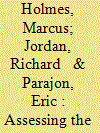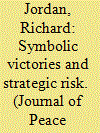|
|
|
Sort Order |
|
|
|
Items / Page
|
|
|
|
|
|
|
| Srl | Item |
| 1 |
ID:
179415


|
|
|
|
|
| Summary/Abstract |
The study of microfoundations, especially individuals, is enjoying a renaissance in international relations (IR) scholarship. Yet, this rise is more difficult to find in publication data. Using the Teaching, Research, and International Policy (TRIP) journal-article database, we show that only 13.7% of IR articles in 12 leading journals use the first image. This proportion remains approximately the same from 1980 through 2018. Interrogating the data, we show that this distribution does not stem from epistemological or methodological commitments, such as positivism, quantitative analysis, or formal modeling. We suggest several reasons for this apparent disjuncture between qualitative assessments of the rebirth of first-image theorizing and the quantitative data that imply a slower or perhaps more limited return.
|
|
|
|
|
|
|
|
|
|
|
|
|
|
|
|
| 2 |
ID:
182666


|
|
|
|
|
| Summary/Abstract |
This article studies the rational side of symbolic victories. It opens with the broad question, why are some battles more significant than others? Extending the literature on bargaining and war, it argues that a belligerent can deliberately increase strategic risk in order to communicate its strength. By increasing the information a battle conveys, the belligerent artificially creates the conditions for a symbolic victory. In short, strategic risk becomes a useful, costly signal. This claim is developed in a formal model in which players choose between more and less dangerous military options. Under most conditions, a symbolic equilibrium exists in which both strong- and weak-type players are able to signal their types after only one round. This equilibrium’s rapid information flow is unusual in the rationalist literature: typically, strong types must wait to signal effectively. The article goes on to establish that, when the prior probability a player is strong is sufficiently small, this symbolic equilibrium uniquely satisfies the intuitive criterion. It then applies the model to two famous episodes from military history, the Doolittle Raid of WWII and the battles of Cannae and Capua of the Second Punic War. For both, it highlights how actors deliberately manipulate strategic risk to communicate with adversaries, allies, and their own publics.
|
|
|
|
|
|
|
|
|
|
|
|
|
|
|
|
|
|
|
|
|